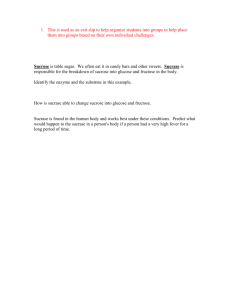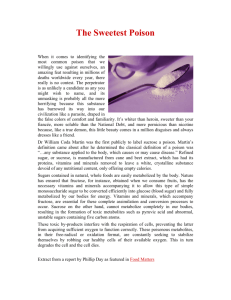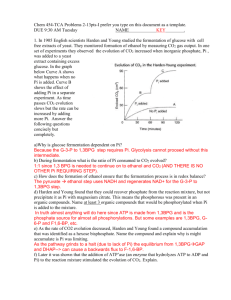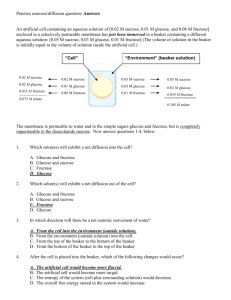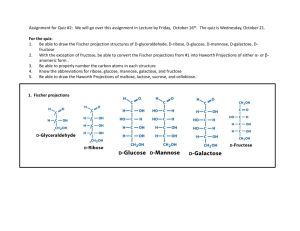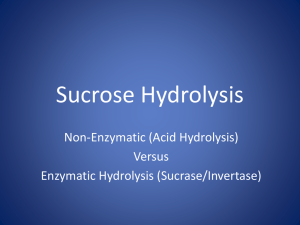polarographic investigation of kinetics of inversion of sucrose
advertisement
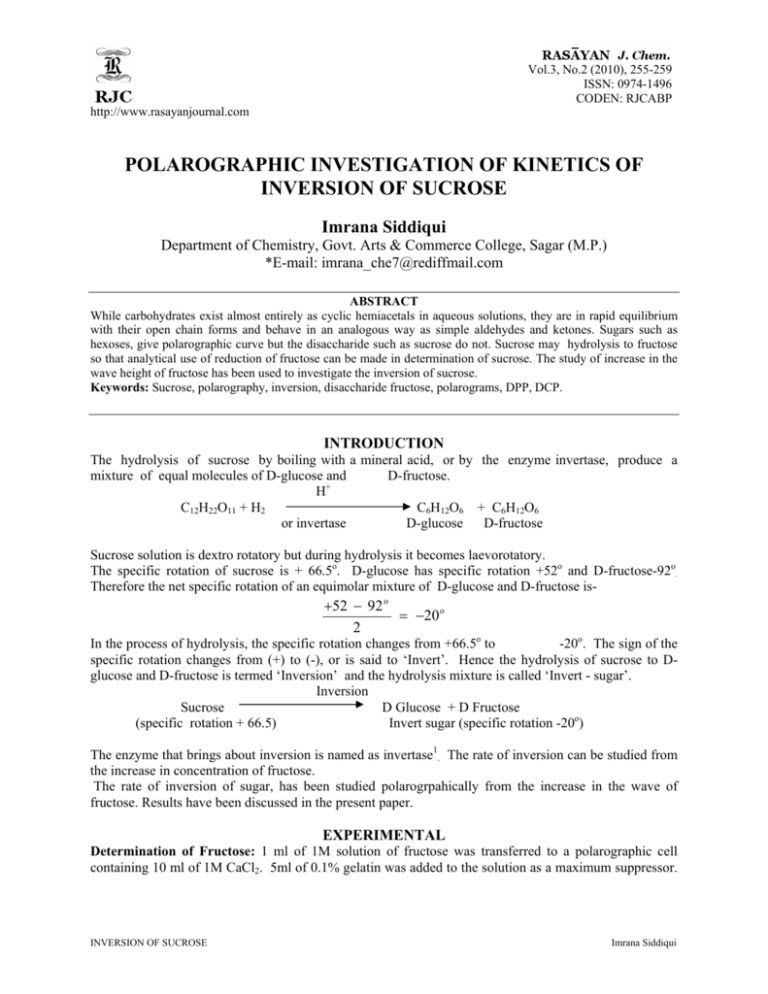
Vol.3, No.2 (2010), 255-259 ISSN: 0974-1496 CODEN: RJCABP http://www.rasayanjournal.com POLAROGRAPHIC INVESTIGATION OF KINETICS OF INVERSION OF SUCROSE Imrana Siddiqui Department of Chemistry, Govt. Arts & Commerce College, Sagar (M.P.) *E-mail: imrana_che7@rediffmail.com ABSTRACT While carbohydrates exist almost entirely as cyclic hemiacetals in aqueous solutions, they are in rapid equilibrium with their open chain forms and behave in an analogous way as simple aldehydes and ketones. Sugars such as hexoses, give polarographic curve but the disaccharide such as sucrose do not. Sucrose may hydrolysis to fructose so that analytical use of reduction of fructose can be made in determination of sucrose. The study of increase in the wave height of fructose has been used to investigate the inversion of sucrose. Keywords: Sucrose, polarography, inversion, disaccharide fructose, polarograms, DPP, DCP. INTRODUCTION The hydrolysis of sucrose by boiling with a mineral acid, or by the enzyme invertase, produce a mixture of equal molecules of D-glucose and D-fructose. H+ C12H22O11 + H2 C6H12O6 + C6H12O6 or invertase D-glucose D-fructose Sucrose solution is dextro rotatory but during hydrolysis it becomes laevorotatory. The specific rotation of sucrose is + 66.5o. D-glucose has specific rotation +52o and D-fructose-92o. Therefore the net specific rotation of an equimolar mixture of D-glucose and D-fructose is- +52 − 92 o = −20 o 2 -20o. The sign of the In the process of hydrolysis, the specific rotation changes from +66.5o to specific rotation changes from (+) to (-), or is said to ‘Invert’. Hence the hydrolysis of sucrose to Dglucose and D-fructose is termed ‘Inversion’ and the hydrolysis mixture is called ‘Invert - sugar’. Inversion Sucrose D Glucose + D Fructose (specific rotation + 66.5) Invert sugar (specific rotation -20o) The enzyme that brings about inversion is named as invertase1. The rate of inversion can be studied from the increase in concentration of fructose. The rate of inversion of sugar, has been studied polarogrpahically from the increase in the wave of fructose. Results have been discussed in the present paper. EXPERIMENTAL Determination of Fructose: 1 ml of 1M solution of fructose was transferred to a polarographic cell containing 10 ml of 1M CaCl2. 5ml of 0.1% gelatin was added to the solution as a maximum suppressor. INVERSION OF SUCROSE Imrana Siddiqui Vol.3, No.2 (2010), 255-259 The volume of the analyte was made up to 100ml with distilled water. The pH of the solution was adjusted to 6.7. Polarogram was recorded keeping the initial emf set to - 1.5V in the presence of air2. Calibration curve was obtained by taking various concentrations of fructose under the identical experimental conditions. Fructose was also polarographed using LiCl as supporting electrolyte. 1ml of 1M fructose was transferred to a polarographic cell containing 10 ml of 1M LiCl. The volume of the test solution was made up to 100ml with distilled water. pH of the solution was adjusted to 7.0 with dilute solutions of NaOH/HCl. The solution was polarographed keeping the initial emf set to -1.6V in the presence of air. Calibration curve was obtained under the indentical experimental conditions with varying concentrations of fructose. Study of inversion of sugar: Polarographically the study of the rate of inversion of cane sugar was carried out with a 6% solution of sucrose in 0.1N HCl in a thermostat at 250C. At fixed intervals of time, a 10ml sample was taken out, made slightly alkaline with 10ml of 1M LiCl and NaOH, diluted 10 times with distilled water and polarographed in air under the identical conditions as discussed earlier. RESULTS AND DISCUSSION The carbonyl group of carbohydrate can be reduced to an alcohol function. The product of carbohydrate reduction is called alditols. Since these alditols lack a carbonyl group, they are, of course incapable of forming cyclic hemiacetals and exist exclusively in non cyclic forms. Reduction of D-fructose yeilds a mixture of glucitol and mannitol (sorbitol and mannitol) corresponding to the two possible configuration at the newly generated chiral centre at C-23. CH2OH CH2OH CH OH 2 C=O HO C H HO C H HO C H H C OH H C OH H C OH H C OH CH2OH CH2OH D- mannitol + H C OH HO C H H C OH H C OH CH2OH Sorbitol Reduction of D- Fructose Sugars such as the hexoses, give polarographic curve but the disaccharides such as sucrose and lactose, do not4. Fructose produces a polarographic wave / peak in 0.1M solution of CaCl2 at pH 6.7 with half wave potential of - 1.65V and peak potential (DPP mode) of - 1.74V vs SCE (Fig.1 and Fig.2 ). There is no change in the E1/2 value with change in pH. However, in an acid medium the hydrogen wave starts before the ketone wave5. Disaccharides (sucrose, maltose, lactose) are reported not to be reduced at the DME6. Analytical use of reduction of fructose can be made in determination of their substances in the presence of sucrose and glucose7. The height of the wave/peak of fructose is directly proportional to the concentration of fructose in the solution. Fig.-1 and Fig.-2 shows the polarographic investigation of the inversion of sucrose from the increase in the wave of fructose. The various curves shown in the figure are obtained by taking 10 ml of solution from 6% solution of sucrose in 0.1N HCl at 25oC, after a definite time (given in hours). INVERSION OF SUCROSE 256 Imrana Siddiqui Vol.3, No.2 (2010), 255-259 1. INVERSION OF SUCROSE 257 Imrana Siddiqui Vol.3, No.2 (2010), 255-259 The fructose wave increases at -1.7V proportionally to its concentration. The reaction- INVERSION OF SUCROSE 258 Imrana Siddiqui Vol.3, No.2 (2010), 255-259 C12H22O11 + H2O Sucrose → C6H12O6 + C6H12O6 Glucose Fructose obeys the first order rate law as the amount of water present is in such an excess that its concentration may be considered to remain constant. The reaction is therefore a pseudounimolecular reaction. It has been studied by observing the increase in the polarographic wave of fructose at regular time intervals. The data has been depicted in Table-1 and 2. The constant value of k shows that the reaction is of first order. On the basis above data and ongoing discussion it could be concluded that the polarographic method is an accurate and reliable method for the study of kinetics of inversion of sucrose. Table-1: Change in concentration of fructose with time Time (Hrs.). 1 2 3 24 48 Concentration of fructose (mM) 0.031 0.059 0.084 0.470 0.609 Table-2: Rate constant for inversion of sucrose t 1 2 3 24 48 a 1.75 1.75 1.75 1.75 1.75 a-x 1.719 1.691 1.666 1.661 1.571 k1 0.0177/hr 0.0166/hr 0.0161/hr 0.0130/hr 0.0096/hr REFERENCES 2. T.M. Meulemans, A . Strok, F. Z. Macaev, B. J.M. Jansen, A . de Groot, Journal of Organic Chemistry, 64(25), 9178(1999). 3. M. Brezina and P. Zuman, Polarography in Biochemistry, Pharmacy and Medicine, Interscience Publishers, INC, New York, 256, 282, 284(1958). 4. F.A. Carey, Organic Chemistry, McGraw Hill Book Co., New York, 1027(1987). 5. J. Heyrovsky and I. Smoler, Collection Czechoslov. Chem. Communs., 4, 521(1932) 6. J. Heyrovsky, I. Smoler, J. Slastny. Vestnik Ceskovlov Akad. Zemedelske, 9, 599(1933). 7. I. M. Kolthoff and J. J. Lingane, Polarography, Inter Science Publishers, John Wiley and Sons, Newyork, IIndEd., Vol II , 675(1965). 8. I. Vavruch, E. Rubes, Listy Cukrovan, 64, 185(1948). (Received: 8 April 2010 Accepted: 23 April2010 RJC-540) Adopt GREEN CHEMISTRY Save Our Planet. We publish papers of Green Chemistry on priority. INVERSION OF SUCROSE 259 Imrana Siddiqui
